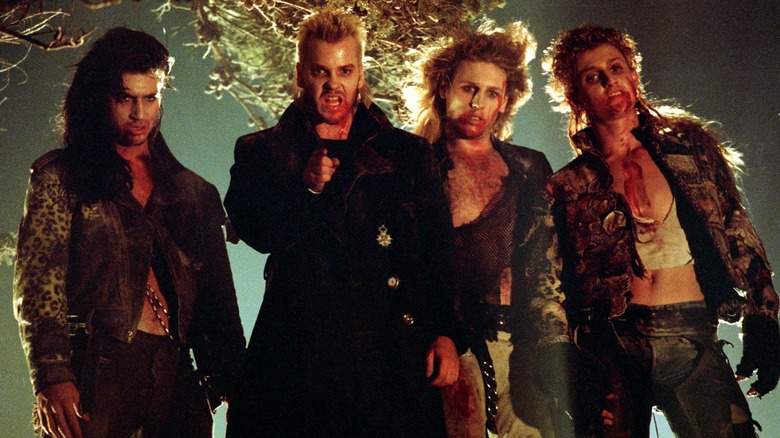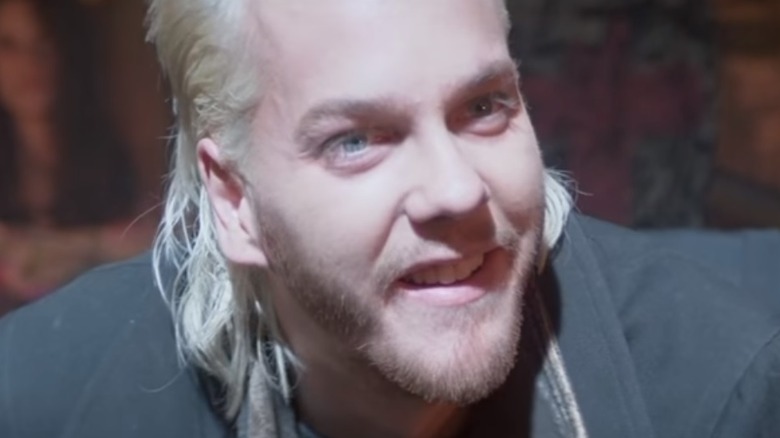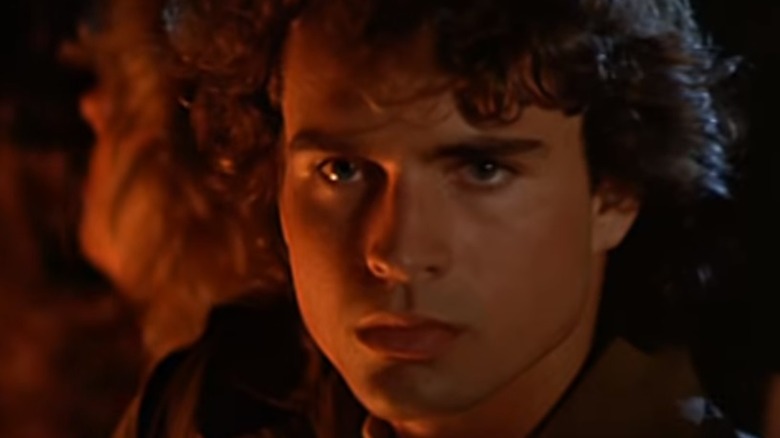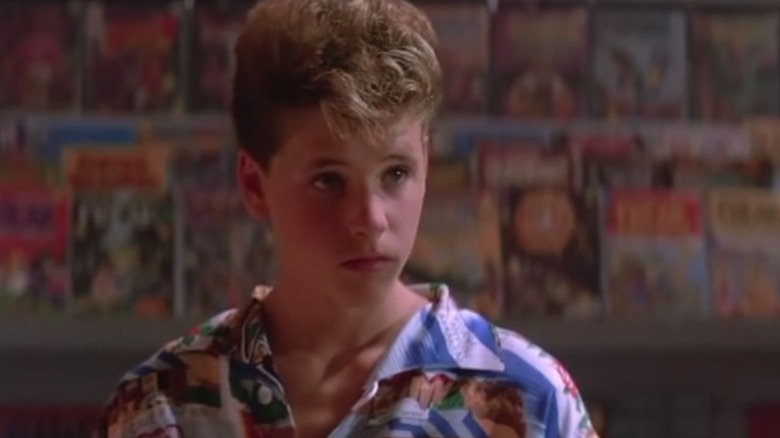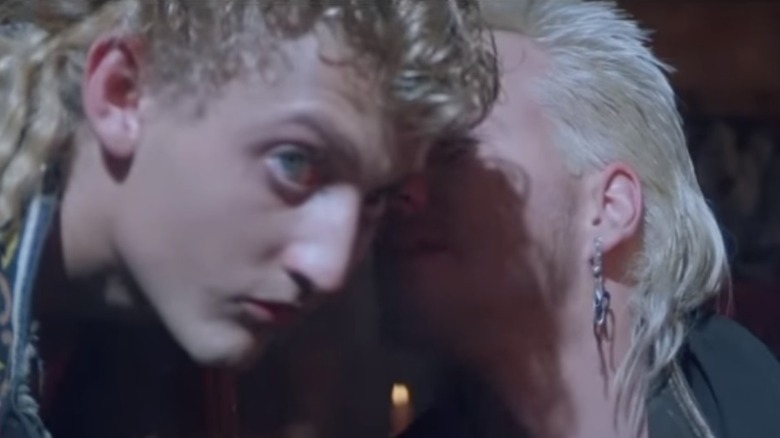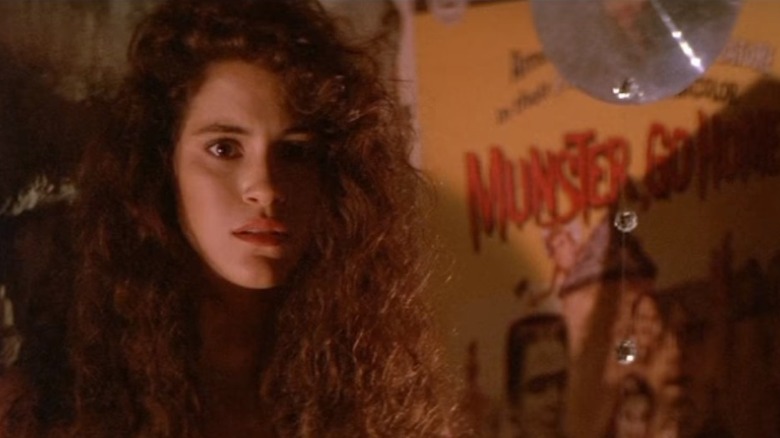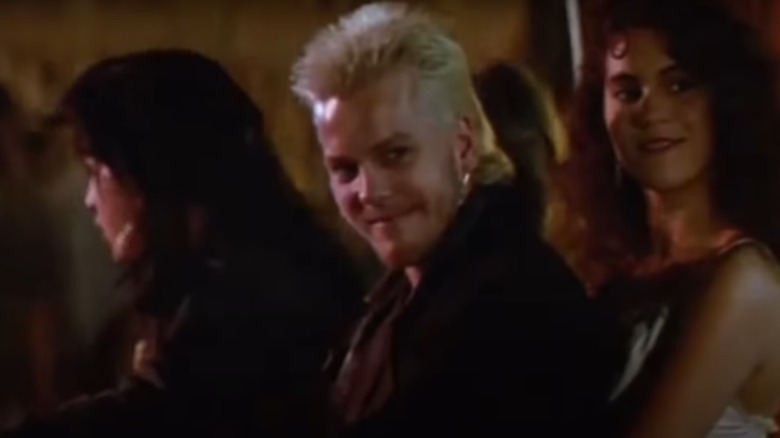Things About The Lost Boys You Only Notice As An Adult
The beach. Motorcycles. Leather jackets and sunglasses. And of course, vampires. These are just a few of the artifacts that you have to put in a circle to summon the late '80s majesty that is The Lost Boys. With an all-star cast of Kiefer Sutherland, Diane Wiest, and the iconic two Coreys (that is, Haim and Feldman), along with contemporaries like Alex Winter and Jason Patric, this teen horror thriller secured a permanent space in the hall of cult classics.
So have you checked it out recently or was the last time you watched it in a Santa Cruz movie theater way back in 1987? If it's been a while, there's a lot you might have missed, so here are some things about The Lost Boys that you only notice as an adult.
It's based on Peter Pan
It's pretty obvious to adults that The Lost Boys is based on Peter Pan. For one, the title itself refers to characters from the original play and subsequent adaptations. If you're a kid, though, you might not notice the connection because the director, Joel Schumacher, made changes to the screenplay to make it sexier. Most notably, he made the vampires older and more attractive, in an effort to avoid making a "Goonies go vampire" film. So while the lost boys of the film may be closer to men, they'll still never grow up or grow old.
Max has access to people's personal information, and that's scary
Back in the '80s, there was no internet so you couldn't pull up Netflix to watch movies on your non-existent smartphone, obviously. Rather, you were at the mercy of your local video store, which would have a limited stock of VHS cassette tapes for rent. And to set up an account, you often had to furnish a copy of your driver's license, often with a credit card to pay for your purchase.
That means the proprietor of the shop would have access to a lot of personal information, including where you live. If you were looking to target people, running a video store was a good way to do it, making it the perfect job for a murderer. So it's not surprising that Max — spoiler alert: the head vampire — chose that profession for himself as the perfect cover. You might not put that together as a kid, but it's hard to miss as an adult.
It portrays divorce realistically
Studies suggest that 40 to 50 percent of American couples will go through a divorce in their lifetime, which is a lot of people. It's well known, too, that divorces can be messy and volatile, as well as traumatic for everyone involved, especially children. And The Lost Boys acknowledges this in a subtle exchange between Lucy and her father toward the beginning of the film, when they first arrive in Santa Carla.
Her father notes that she didn't "improve her situation" through her divorce, while Lucy argues that "a big legal battle wasn't going to improve anybody's situation." So Lucy clearly isn't getting much support in the form of alimony, but she walked away just to have a clean break, which is understandable.
There are other moments where it's addressed again, such as when Max assures Sam that he's not trying to replace his father during the dinner scene. It's all handled in a very real, adult way.
Michael stalks Star
Michael may not be the villain in the film, but he certainly has a creepy streak. This is most evident in his pursuit of Star, who catches his attention while dancing during the iconic "I Still Believe" scene. He stares at her, obviously overcome with desire, even though he's never even had a conversation with her. He then proceeds to stare at her pointedly, not looking away until she acknowledges his gaze.
When she eventually turns and leaves, he follows her out of the venue and it's honestly really creepy — women don't appreciate strange men following them home in the dark. It sounds like everyone can empathize with Sam, then, who at one point proclaims to Michael that he's "at the mercy of [Michael's] sex drive."
Michael inexplicably knows where Hudson's Bluff is
By the time Michael catches up with Star after the concert, she's back with the other vampires, who are poised and ready to ride out on their motorcycles. But David doesn't shoo Michael away as you might expect. Instead, he presents Michael with a challenge, daring him to keep up with the pack. He then asks Michael if he knows where Hudson's Bluff is — which is where the vampires sleep — and surprisingly, Michael says he does.
He just moved there, so how is it possible that he's telling the truth? Unless of course in the years of visiting his grandfather in Santa Carla, he's learned about Hudson's Bluff. But during the chase, he comes inches away from riding his bike off of a cliff to a watery death, affirming that he's clearly not familiar with the area.
There are gay undertones
You wouldn't pick up on any of this as a kid, but The Lost Boys has a host of gay undertones, ranging from fan theory to frank observations. For one, Sam is not exactly the pillar of hegemonic masculinity. Rather, he's a sensitive, tender person who's always wearing bright, flamboyant clothing, which arguably could just be a coincidence. But couple that with the fact that he sings in the bathtub about not having a man and has a giant, sexy Rob Lowe poster in his literal closet, and it seems more obvious that he could be gay.
Then there are the vampire boys, who all sleep in the same room and do everything together. Could it be, perhaps, that their leather-forward outfits hint at an interest in the underground gay culture of the 1980s? They all drank David's bodily fluids, after all, so it's not out of the realm of possibility. And why are none of them hooking up with Star, the only woman who's ever around? That would certainly explain the dramatic tension between David and Michael.
Sexy sax man has become an icon
It's impossible to discuss homoeroticism in The Lost Boys and not mention sexy sax man, the glistening, muscle-bound heartthrob performing front and center at a concert with majority male attendees. He alternates between singing, playing the saxophone, and gyrating while wearing only tight purple pants, a codpiece, and a selection of jangling chains. Sam and Michael can't help but bust out big grins when they see him for the first time.
Back in the 1980s this didn't seem like such a big deal, as the style of the times was certainly flamboyant. But as an adult, sexy sax man definitely qualifies as a gay icon. He's become something of a legend, captivating audiences and inspiring a Saturday Night Live parody skit featuring Jon Hamm playing Sergio.
The lead actors are all white
The fictional city of Santa Carla is apparently quite white, as all of the lead actors in The Lost Boys are Caucasian. Some minorities were cast in smaller roles, as is evident during the "People Are Strange" montage, where Latinx folks are featured prominently. Additionally, the host who lets Lucy use the restaurant phone is black.
But Santa Cruz, the city Santa Carla was based on, shows a little more diversity in the demographic data from the 1980s and 1990s than that, making a case for at least one lead to be a person of color. It's not surprising that this didn't happen though, as studies show that Hollywood has a pretty severe diversity problem.
It fails the Bechdel Test
In addition to a lack of racial equality, there's not a lot of gender diversity in film either, which fails the Bechdel Test pretty remarkably. While there are two female lead characters with names — Lucy and Star — they never have a conversation with each other. And since they never speak, the third criteria, which is that they talk about something other than men, doesn't apply.
Some folks have argued that Lucy asks Star "Who are you?" at the end, but that's not what was said. Instead, Lucy asks the entire room "Who's this?" which is even worse. She didn't even ask Star herself who she was, denying her the agency of answering.
There's a gang initiation
David and the other vampires put Michael through a hazing so intense that it could qualify as a gang initiation. According to Dr. Mike Carlie, an emeritus professor of sociology and criminology at Missouri State University, one way that gangs initiate members is called Blood In or Blood Out — they either kill someone to gain entry into a gang, or kill someone to be allowed out of the gang. The Southern Poverty Law Center has a different definition of Blood Out, meaning that you only leave the gang when you die, but either definition works here.
So when David and the other vampires descend on a group of Surf Nazis (conveniently when "Walk this Way" is playing, signaling conformity) and go on a killing spree, Michael is expected to participate. Doing so would make him a full vampire, as well as an official member of their tribe. But Michael holds back, never fully joining the gang.

